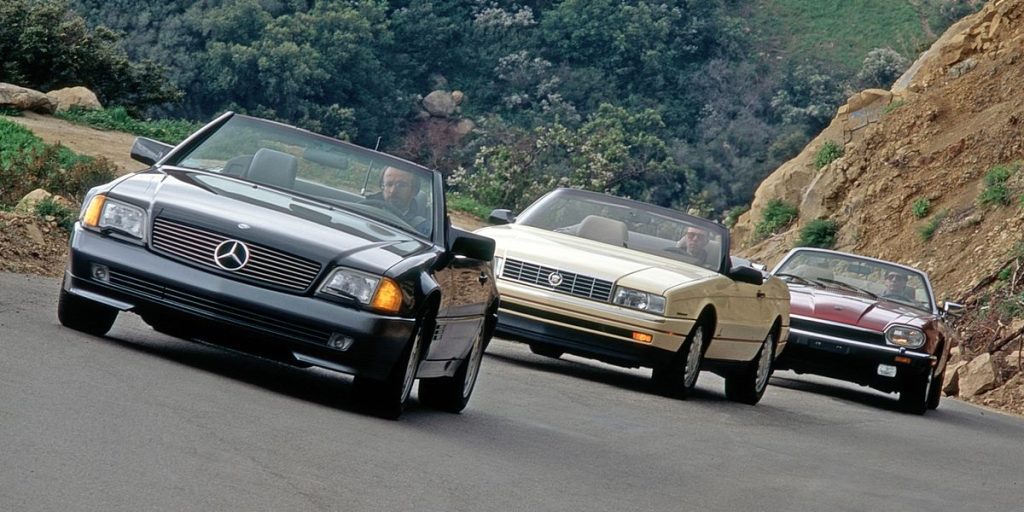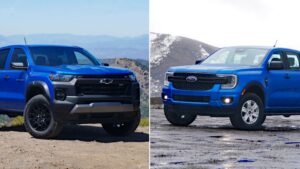From the Archive: Cadillac, Jaguar, and Benz Square Off in a 1992 Luxury-Convertible Showdown

From the July 1992 issue of Car and Driver.
You should probably be sitting down when you read what these cars cost. We all know that Cadillac, Jaguar, and Mercedes-Benz make interesting automobiles and that convertibles are always premium models. And there’s no question that the Allanté, the XJS, and the 300SL have great appeal. But they all have serious shortcomings, too. We’re not sure that should be allowed at these prices.
Look what the combined efforts of car-company marketers and government revenuers have done. Counting manufacturer’s suggested retail price, freight, gas-guzzler penalty, and luxury tax, the Jaguar XJS convertible now costs nearly $72,000. And except for the folding top and numerous detail refinements, it is the same basic car the company introduced in 1975: elegant, yes, but also heavy, cramped, and thirsty. And it’s still hobbled by the same slushy GM three-speed automatic transmission—which GM quit using generations ago.
The Mercedes-Benz 300SL is the newest design here and clearly the most modern. But it is also the most flagrantly priced car, at an astounding $90,335. That hit would perhaps be a little easier to take if a $12,000 Ford Escort LX-E didn’t trounce the ostensibly sporty Benz by a full second in 0-to-60 and the standing quarter-mile.
Then there’s the Cadillac Allanté, the bargain-basement ragtop of this group at $64,843. The new Northstar four-cam V-8 is a gem, but Allantés have been too expensive ever since the original was introduced at $56,000 (in 1986 dollars). Even if its competitors’ price increases have somewhat outstripped its own, the Allanté forges on into the $60,000 bracket with its flexible structure and problematic top still intact.
Of course, these are flash cars, selected by emotion more than logic. But every judgment of an automobile must be made with one eye on the asking price. With that firmly in mind, we set off with these exclusive convertibles: the new 1993 Allanté, with its 32-valve V-8 engine, friendlier seats, and revamped rear suspension (C/D, February 1992); the XJS, which sports some subtly revised sheetmetal and a reworked interior (C/D, July 1991); and the 3.0-liter six-cylinder version of Mercedes’ SL two-seater, unchanged since its 1990 debut (C/D, September 1989). We gathered performance data at Willow Springs Raceway and ran up a zillion miles looping through the coastal mountains to Ojai and Santa Barbara before droning back to Los Angeles. Then we pondered the meaning of it all, and let the scores fall where they might.
And fall they did. Note that the Overall Rating numbers, in addition to clustering almost too close to call, barely broke out of the low eighties. The winning score was the lowest in recent comparison-test history. It’s almost a shame to cite winners and losers under such circumstances, but here is our call.
3rd Place: Jaguar XJS V12
Many of us have long had a place in our hearts for the velvety V-12 Jaguar sports tourer. The XJS enjoyed an extensive, if subtle, rework for 1992, incorporating new headlamps, taillamps, and grille, plus faintly bolder contouring of the rocker panels and hood bulge. (The coupe version also had its rear-quarter windows reshaped.) And a complete refurbish inside included new power-adjustable seats, a new wheel, and a new instrument panel with proper round gauges set in walnut.
HIGHS: Great to be seen in, rides like the QE2.
LOWS: Too many details feeling too dated.
VERDICT: There will always be an England; this XJS, too?
Despite the upgrades, however, the XJS remains an aging design. Modern efficiencies—0f space, weight, and energy—go unrecognized by this regal conveyance. The huge engine/transmission assembly squeezes passenger space, and the conversion to a soft-top transform an already weighty two-plus-two coupe into a staggeringly heavy (4160-pound) two-seater—one that turned a gallon of unleaded premium into heat and smog every thirteen miles on our trip.
Does all this mean we didn’t like driving the XJS convertible? Hardly. The big Jag rides beautifully, it has a sleek look and a stately demeanor, it makes respectable time over most roads, and it is in many ways the most flattering car of this group to be seen in. Though the steering feels more vague and slow than we like, the car can be guided through bends with fine balance—impressive, given the extremely soft suspension. And any time the tach is showing over 4000 rpm, the big V-12 can deliver good thrust. So certainly for posing, cruising, touring, and swooping through the mountains at a six-tenths pace, the XJS does the job.
But for 5.3 liters and a quoted 276 horsepower, the big twelve doesn’t deliver much kick. Only the presence of the embarrassingly underpowered 300SL saved the XJS from the wrong kind of performance distinction in this test. And the V-12 gets little help from the Turbo-Hydramatic three-speed automatic; this transmission works fine by decade-old standards, but today its shifts feel lazy and its selector lever balky.
The Jag scores pretty well as a convertible. It suffers only minor drafts in the open cockpit, and its easy-to-manage top mechanism—manual latches and power up-down, but a too-tight snap-on boot—is surpassed here only by the Mercedes’ magical one-touch system. In body stiffness, though, the XJS takes the booby prize, flexing and shaking more than the others.
Frankly, for anyone who doesn’t need to have a convertible, the XJS coupe makes a vastly better automobile, with much greater structural rigidity, more useful space, 200 fewer pounds, and a pricetag $7000 friendlier.
1992 Jaguar XJS V12
290-hp V-8, 3-speed automatic, 4815 lb
Base/as-tested price: $71,888/$71,888
C/D TEST RESULTS
60 mph: 8.7 sec
1/4-mile: 16.7 sec @ 87 mph
100 mph: 22.3 sec
120 mph: 45.9 sec
Braking, 70–0 mph: 179 ft
Roadholding, 300-ft-dia skidpad: 0.73 g
C/D observed fuel economy: 13 mpg
2nd Place: Mercedes-Benz 300SL
Hopping into today’s Mercedes two-seater and feeling the solidity and quality, we could almost forgive Daimler-Benz for dragging the hallowed 300SL name down off its pedestal and thrusting it into the melee of the modern market. Then we stood on the throttle for a quick getaway and got all steamed up again. This thing should have been at least a 320SL, using the 3.2-liter six now fitted in the 300SE. That engine’s fourteen-percent torque advantage would be a help because, as it is, the SL’s 3980 pounds completely overwhelm the poor little 3.0-liter six.
HIGHS: Body rigidity, five-speed automatic, robo-top.
LOWS: Too many bucks, too few horses.
VERDICT: Makes the $107,000 500SL look like a must-buy.
Get past its acceleration rate, though, and the 300SL begins piling on rationales for its shocking sticker. The apparent stiffness of its body structure is remarkable, with only a rare hint of shudder in the cowl. The chassis is far and away the most advanced and best settled in this group, giving the SL a secure, confidence-inspiring chuckability over fast, undulating roads of any surface, as well as a fine freeway ride. Its comfortable seats—more like occupant-support systems, really—incorporate the whole safety-belt mechanism plus the usual power adjustments. Each unit probably costs and weighs as much as a Hyundai. Then there’s the pop-up rollover bar, the clean body lines, the high quality of the finish—on and on.
And don’t forget that top, the easiest and trickest in creation. Hold a single button on the center console and watch with wonder as eleven solenoids, fifteen hydraulic servos, and seventeen proximity switches run their routine, throwing latches, raising panels, cranking the top as bidden, and buttoning everything down. Amazing. (Yeah, we know 1960s Lincolns did the same thing. But they didn’t come with an automatic roll bar, did they?) The Mercedes also includes a removable hard top—an amenity that is $2000 extra with the Cadillac and not offered at all with the Jaguar.
And give credit where it’s due: though the 300SL lagged behind the Allanté and XJS in all tests of acceleration and speed, it cleaned house in braking distance, skidpad grip, and fuel economy (according to both the EPA’s test cycle and our trip log).
So there’s no question the 300SL delivers some value. But in this comparison, and considering that lofty price, it wasn’t enough to bag all the chips.
1992 Mercedes-Benz 300SL
228-hp inline-6, 5-speed automatic, 3980 lb
Base/as-tested price: $90,335/$90,335
C/D TEST RESULTS
60 mph: 8.8 sec
1/4-mile: 17.0 sec @ 85 mph
100 mph: 25.0 sec
120 mph: 48.5 sec
Braking, 70–0 mph: 175 ft
Roadholding, 300-ft-dia skidpad: 0.80 g
C/D observed fuel economy: 19 mpg
1st Place: Cadillac Allanté
Cadillac’s Pininfarina-made Allanté roadster has always seemed too posh to be a sports car but too brash to be a luxury cruiser. It targeted the two-seat Mercedes on price, performance, and accommodations but has never had the substance to go head-to-head with the high-quality, high-resale-value Benz.
A half-dozen years after its launch, however, the Allanté has inherited a huge price advantage. With the SL breaking through $90,000 (even in the “cheap” six-cylinder form tested here), the new Allanté’s 1993 base price of $64,843—including the mandatory luxury and gas-guzzler taxes—suddenly looks almost reasonable.
HIGHS: Great new powertrain, friendly handling.
LOWS: Shaky structure, bland interior, fussy top.
VERDICT: Still pricey, but a decent value by comparison.
But even bigger news for 1993, and the thing that makes the Allanté finally worth taking seriously, is the arrival of the much-anticipated Northstar V-8. This impressive new 4.6-liter powerplant brings Lexus/Infiniti-class technology, power, and smoothness to the domestic camp, even though the Allanté’s Italian body assembly gets it classed an import. This brilliant all-aluminum multivalver delivers 290 horsepower through a slick and responsive new four-speed automatic.
In every contest of speed and response, Cadillac’s Allanté has it all over the Mercedes 300SL and the Jaguar XJS. Punching the Northstar’s throttle to leap into a hole in traffic on Santa Barbara’s crowded State Street, or to launch out of a slow bend on serpentine Highway 33, always brought an effective boot in the back. And a nice exhaust growl, too.
Though 290 horsepower sounds like too much to send through front wheels, the Allanté’s new chassis manages the challenge just fine. There are reworked struts in front and unequal-length arms replacing the former struts in back, plus variable damping that reads and reacts to wheel travel in quasi-active fashion. The car does not have the sense of near-perfect balance and fine damping of the 300SL, and it certainly doesn’t have the structure, but the Allanté feels easy, natural, and willing when the corners are coming up thick and fast. Stopping distances with our test car were on the long side, due perhaps to tire choice or the car’s extreme forward weight bias. But otherwise, the sportiest Cad performed with distinction.
Even if it scored well enough to win here, though, the Allanté still gives us some things to wonder about. Such as, do its customers really like an instrument panel that’s all straight lines, right angles, and fields of identical buttons? Is its interior trim rich enough for this price range? Couldn’t the structure be tightened up? Don’t the proprietary GM ignition switch and transmission selector feel sloppy in a $60,000 automobile? And why did the manually operated, power-latched top fit as if it were a half-size too small, forcing us into energetic tricks to get both ends attached?
Ah, well, maybe we’re being too hard on these things. Cars like these may come up short on normal automotive value, but they aren’t really normal automobiles. These are boutique cars, purchased largely as fashion accessories. You don’t buy an Armani suit to keep warm.
The reality is, an open car will always be more complex and costly to create, and it can hardly avoid being heavier, less sturdy, less efficient, and less comfortable as a result of its convertibility. That hinders the car’s effectiveness, but it isn’t really an argument for eliminating the open-air option. There is something undeniably opulent about an expensive car with its top folded away and its occupants on display.
For the right people (wealthy, and willing to look it) and the right missions (tennis, lunch, shopping, or a cruise down the Coast Highway to Sunday breakfast), the Allanté, the XJS, or the 300SL could work just dandy. But you’ll just have to forgive the manufacturers if the bold prices of this trio seem to promise a broader repertoire than that.
1993 Cadillac Allanté
290-hp V-8, 4-speed automatic, 3720 lb
Base/as-tested price: $64,843/$64,843 (est.)
C/D TEST RESULTS
60 mph: 6.2 sec
1/4 mile: 14.8 sec @ 95 mph
100 mph: 16.7 sec
120 mph: 27.0 sec
Braking, 70–0 mph: 196 ft
Roadholding, 300-ft-dia skidpad: 0.77 g
C/D observed fuel economy: 16 mpg
This content is imported from OpenWeb. You may be able to find the same content in another format, or you may be able to find more information, at their web site.


